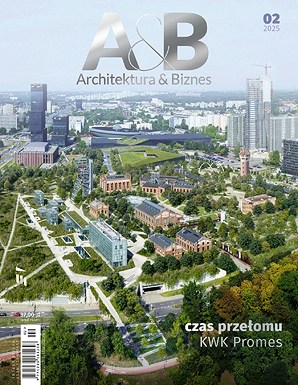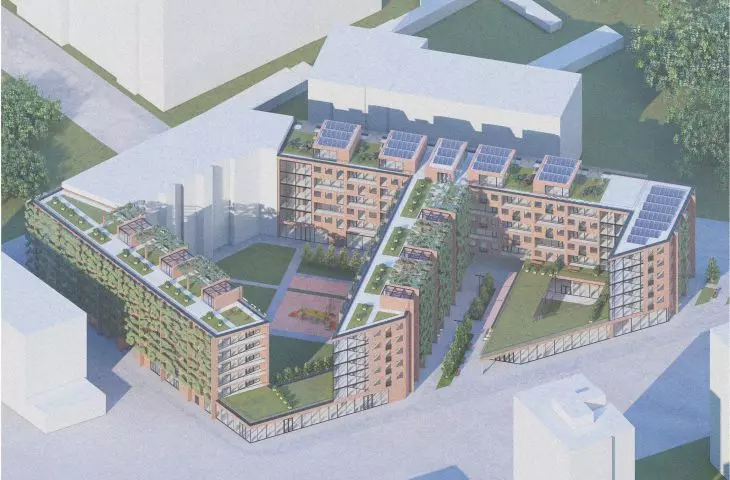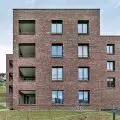Full of greenery and social space, the habitat is a project by Krystian Cięciwa, a student at the Faculty of Architecture at Wroclaw University of Technology. The environmentally-friendly housing estate, located near Wroclaw's Botanical Garden, consists of a galleried building and two staircases covered with green roofs. The buildings have several types of apartments - all equipped with balconies or loggias.
View from Wyszyńskiego Street
© Krystian Cięciwa
The presented project was created under the direction of Dr. Anna Berbesz.
While conducting design analyses, I noticed that the plot is located in an interesting place in terms of urban planning . On one side there is a historical quarter development, and on the other side there are detached buildings. When designing, I wanted to fit into the existing urban context, so I decided to combine the two layouts. On the side of Kardynała Bolesława Kominka Street and Hlonda Street I proposed brick buildings, referring to the historical solution. On Wyszyńskiego Street, I designed three lanes facing the roadway. This treatment causes that while moving along Wyszynski Street there is an apparent play of blocks, which give the impression of free-standing buildings. This solution alludes to the modernist blocks of flats standing opposite the project plot," Krystian Cięciwa says about the design work.
The designed habitat is located between Kardynała Bolesława Kominka and Hlonda streets
© Krystian Cięciwa
six types of housing
The habit at consists of one gallery building connected to a corridor section and two cage houses. The gallery on the side of Hlonda Street allows observation of the botanical garden in the area. The student designed two types of mirrored apartments, two types of two-story apartments and two types of corner apartments. Another important design consideration was the addition of either a loggia or balcony to each apartment. Meanwhile, the apartments in the staircases have balconies connected to the green wall structure.
A frontage connecting the streets
Another important design consideration was the creation of a pedestrian front age connecting Wyszynski and Hlonda streets. Conducting traffic analyses, Krystian Cięciwa noticed trampled paths in the lawn, which are most often used by residents. He decided to diversify this route by introducing a restaurant, café, art gallery and services.
walking frontage
© Krystian Cięciwa
social zones
Within the premise, the student proposed two social zones where residents can meet. One of these places is located in the intersection of the gallery building on the side of Hlonda Street and the cage building extending towards Wyszynski Street. There are seating areas and several tables. The second community zone is located at the corner of Kominka Street and Cathedral Square. The zone there has an overhang overlooking the square along with the buildings.
When designing the development of the plot, I paid attention to ensure that the space was also intended for residents of other buildings in the area. Also, the roof of the habitat is usable - residents can use it during the summer season. Green roofs with low greenery positively affect the perception of the whole establishment, the author adds.
The facades are covered with brick and plants
© Krystian Cięciwa
pro-ecological values of the habitat
Thepro-ecological factor of the project was very important to me. The close proximity of the botanical garden motivated me to design a habitat that would be solved in harmony with nature, Krystian points out.
The student included in the design a high ratio of biologically active area, green roofs and facades, and photovoltaics. In addition to aesthetic value, these solutions have a positive impact on the ecosystem and reduce the problem of heat islands in the city and overheating of buildings.
































